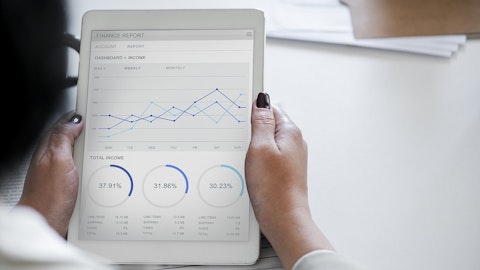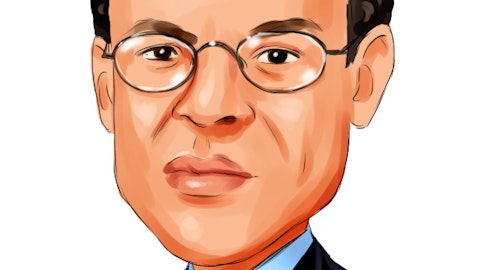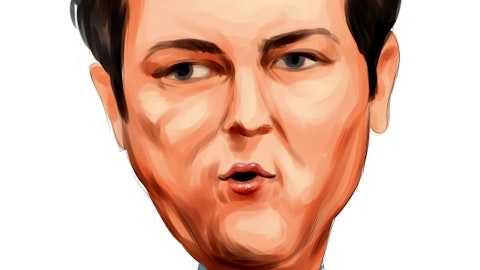Operator: Thank you. The next question is coming from Ghansham Panjabi from Baird. Your line is now live.
Ghansham Panjabi: Thank you. Good morning, everyone.
Chris Villavarayan: Good morning.
Ghansham Panjabi: Just given the real-time sequence in China as it relates to the reopening, can you just give us a sense as to where volumes are by sub-segment relative to perhaps the pre-COVID levels?
Sean Lannon: Yes, I mean the first quarter is typically fairly soft for us, Ghansham, with Chinese New Year and even the infection rates in the first two weeks in January. But I mean we’re cautiously optimistic for ’23. I think the first quarter is going to be pretty soft. Mobility has actually run pretty strong. Other than the COVID lockdowns in the second quarter, they’ve propped above that market, and it’s run pretty well in Q3 and Q4. Refinish, with all the lockdowns, just impacted miles driven. So, that’s probably the one region that just sort of further behind just given the COVID lockdowns. And Industrial, same thing, just given general slowdown in some of the European economic markets, the export market in China has impacted Industrial, and again just the COVID impacts. But again, we’re cautiously optimistic we’ll see slow recovery here. But we’re pretty cautious on the first quarter guide as it relates to China.
Ghansham Panjabi: Where did auto Refinish in China finish 2022 relative to 2019 levels?
Sean Lannon: That’s a good question, Ghansham. We’re certainly down a few points, probably high single digits opposite 2019.
Ghansham Panjabi: Okay, fair enough. And then on slide nine, you have the historical and projected builds in global light vehicles, nice little chart there. So, assuming we get to 2019 levels by, let’s say, 2024, is there any reason why you would not be above the 2019 EBIT margin levels for that segment, assuming that Commercial kind of hangs in and raw material cost inflation is relatively muted relative to price ?
Chris Villavarayan: Maybe I’ll start off. Again, it’s as you can see from our year guide, we’re certainly going up. And we’re also a little bit lower than where the external forecasters are because we’re being somewhat conservative. But again, Ghansham, I think what you have to take into consideration is the inflation that we have faced in the marketplace, right? And then offsetting that margin gap on the top end between where we were at the full look with cost inflation built in. However, if you look quarter-by-quarter, even if you go into Q1, we’re driving increased margins in the Mobility business, and that’s the objective going forward. As you know, if you went back to, let’s call it, Q1 levels, we were running at about $35 million. And this quarter, we were at $22 million, so we’re — or we’re — the Q1, we’re building into ’22. So, certainly we’re progressing in the right direction, but still a ways to go there.
Ghansham Panjabi: Okay, perfect. Chris, look forward to meeting you at some point.
Chris Villavarayan: Absolutely.
Operator: Thank you. The next today is coming from Vincent Andrews from Morgan Stanley. Your line is now live.
Vincent Andrews: Thanks, and good morning, everyone. Could I ask on the Mobility pricing in the quarter, how much of that was new bespoke pricing versus the flow-through of the indexation contracts?
Sean Lannon: Yes, so fourth quarter, actually the vast majority was new pricing contract negotiations as opposed to raw material indexing. When you think about the whole year, it’s probably a 50-50 split as far as the contribution between raw material indexing and just pricing negotiations.
Vincent Andrews: Okay, that’s helpful. And Chris, maybe just preliminarily, you talked in that slide about the sort of strategic goals. When you think about operations and supply chain, is the stuff that you’re envisioning, is this sort of more tactical and nimble stuff or is it more sizable restructuring kind of stuff that would have significant cash costs associated with it?
Chris Villavarayan: Well, three weeks in, probably a little early to call, Vincent. But what I’m absolutely focused on right now is more the tactical and nimble stuff because we have to react absolutely quickly here, continuing the path that Rakesh and the team have built up, and obviously the monumental step-up they did in Q4, and we got to continue that through Q1, Q2, Q3. So, the first step is just purely focused on driving those execution aspects, whether it’s utilization of our plants better, whether it’s procurement, and whether it’s our supply chain improvement. So, those are the drivers we’re driving initially.
Vincent Andrews: Okay, fair enough. Thanks for the questions.
Chris Villavarayan: Sure.
Operator: Thank you. The next question is coming from Alex Yefremov from KeyBanc Capital Markets. Your line is now live.
Alex Yefremov: Thanks. Good morning, everyone. In fourth quarter, sequentially, your sales were about flat, your EBIT was about flat. And yet your price-cost gap runs by $56 million sequentially. I guess the question is why didn’t more of that price-cost benefit show up in EBIT, and would it show up sometime later?
Sean Lannon: Hey, , good morning. The big thing is refinish volumes. Q4 and Q1 are typically the soft quarters from a refinish perspective. So, coming off Q3, that’s really where you see sort of some margin compression. Obviously nothing structural, just the seasonality of how Refinish works, Alexi.
Alex Yefremov: Okay, that’s helpful. Thanks a lot. And then — and also talk about E-coat on EV battery components, could you talk about that product, what’s your content? What is the gross opportunity there?
Sean Lannon: Yes. I mean — and you’re probably referencing a press release that came out few weeks ago, where we won an award. But it’s really the entire infrastructure of an EV vehicle where the E-coat is going on. So, as far as our EV exposure within Energy Solutions, on that, roughly, $130 million business, it’s still sitting around 30%. So, it’s still pretty small, but obviously a bigger opportunity for us longer-term.
Alex Yefremov: Thanks a lot.





